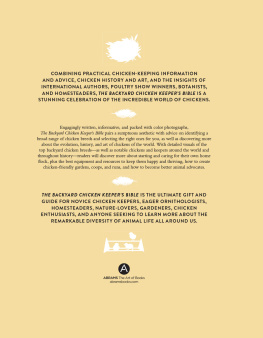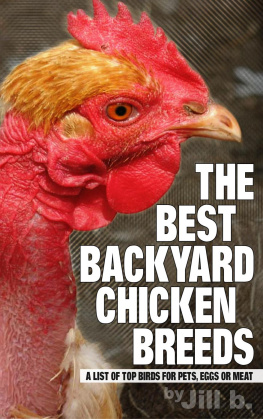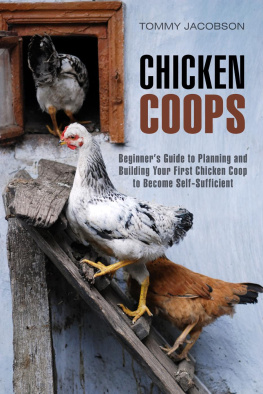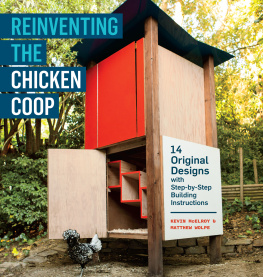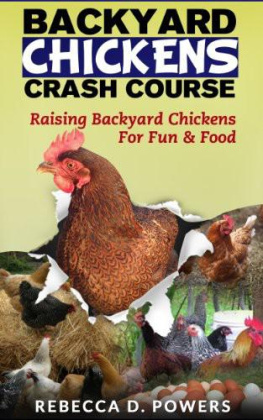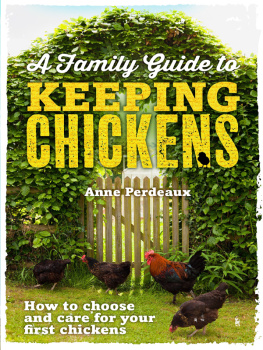CHICKEN & EGG
Raising Chickens to Get the Eggs You Want
Andy Cawthray
&
James Hermes


If you long to add some feathered friends to your nest and want to look no farther than your backyard for farm-fresh eggs, Chicken & Egg is the chicken-keeping guide for you. This informative volume focuses on chicken husbandry from the vantage point of egg production, providing expert instruction in how to optimize laying, choose chicken breeds based on egg color, and even affect the flavor of your eggs while caring for happy, healthy hens. Chicken & Egg features beautifully illustrated profilesincluding appearance, egg characteristics, laying traits, broodiness, and moreof fifteen top egg-laying breeds. Also included is a handy troubleshooting guide to help you overcome common problems experienced by chicken-keepers.
In Chicken & Egg, youll learn:
How todays chicken breeds originated and became domesticated
The science behind egg production, incubation, and hatching
The differences between good-quality and poor-quality eggs
How and where to purchase your chickens
The basics of chicken-keeping, such as how much space you need, how to choose an appropriate henhouse, how to keep your chickens safe from predators, and what to feed your flock
First published in the United States in 2015 by
i-5 PUBLISHING, LLC
3 Burroughs, Irvine CA 92618
www.facebook.com/i5Press
www.i5publishing.com
Copyright 2015 Ivy Press Limited
All rights reserved. No part of this book may be reproduced or transmitted in any form or by any means, electronic or mechanical, including photocopying, recording, or by any information storage-and-retrieval system, without written permission from the copyright holder.
Print ISBN: 978-1-620-08150-1
eISBN: 978-1-620-08202-7
The Library of Congress Catalog-in-Publication Data has been applied for.
This book was conceived, designed and produced by
Ivy Press
Creative Director: Peter Bridgewater
Publisher: Susan Kelly
Editorial Director: Tom Kitch
Art Director: James Lawrence
Editor: Jamie Pumfrey
Design: JC Lanaway
Paintings: Kate Osborne
Color origination by Ivy Press Reprographics

Contents
Preface
When considering chickens, the question always arises: Which came first, the chicken or the egg? This single conundrum has plagued the great thinkers of human civilization for millennia. Of course, it has no real answer because its purpose is simply to illustrate that some questions dont have answers, and yet the debate will continue long into the future. However, while the debate rages with little chance of any resolution, we have chickens and eggs to fill our lives with both pleasure and nutrition.
The chicken has become entwined in the lives of most of the worlds population. In any restaurant or caf, chicken and eggs are prominent fare on the menu. In knick-knack and general-household stores, chickens of all shapes and sizes are prominently on display, immortalized in stylized paintings and sculptures, and chicken feathers are found in many crafts, hats, pillows, and fishing flies. Chickens have also become part of our language, in sayings such as Dont put all your eggs in one basket, Dont count your chickens before theyve hatched, Youve got egg on your face, The hen-pecked husband flew the coop, and Dont get your hackles up.
In recent years, the poultry and egg industries have become the primary producers of protein consumed by over half of the population of the world. The chickens used to produce these foodstuffs have developed into the most efficient traditional livestock species on the planet, returning the highest level of productmeat and eggsfor the least amount of feed.
In small farms and even in urban settings, chickens have gained in popularity. Small flocks of a handful of hens are supplying eggs to many families and their neighbors while providing life lessons, responsibility, and the hard realization of life and death to countless numbers of children.
This book will lead the reader through the origins and history of the birds we know as chickens. The complexity of the lowly egg is explained, including how it is formed, its quality criteria, and the conditions that result in baby chicks. Potential and new small producers will learn of the variety of egg-laying breeds and their temperaments, as well as the basic management conditions and practices required to house a small flock, including the proper care and feeding of these impressive animals.
We may not answer the questions as to why the chicken crossed the road or whether the chicken or the egg came first, but we will lead you on an exciting journey into the world of the chicken and the egg.

INTRODUCING
THE CHICKEN & THE EGG


CHAPTER ONE
CHICKENS
What Are They?
Chickens are a group of domestic birds that have been associated with man for millennia. Since their domestication for use as livestock animals, they have been a source of wonder and amazement, as well as becoming one of the primary protein sources in the human diet, in the form of chicken meat and eggs.

A Brief History
Chickens are essentially a domesticated pheasant native to Southeast Asia. They are classed with similar birds in the taxonomic order Galliformes (commonly called gamebirds or galliforms), which, in addition to the chicken and its wild progenitor, the jungle fowl, include turkeys, pheasants, quail, partridges, guinea fowl, and peafowl. Galliforms in general are adapted to life on the ground. While they can fly, none is a strong flyer, and most species use this ability for the primary purpose of avoiding predators; an explosion of wing-flapping to take off (the flush) startles the predator and lasts for only a few moments, with the bird landing a short distance away and the predator standing confused and without a meal.
In the beginnings of their association with man, early pre-chickens were relegated to a recreational role. It is generally accepted that jungle fowl were originally taken into captivity for fighting contests, with the winning roosters gaining the right to produce the next generation. As jungle fowl morphed into chickens during the ensuing millennia, fighting skills remained high on the priority list for selection. Egg and meat production were inconsequential during the domestication and early development of the chicken.

Red jungle fowl, a member of the avian taxonomic order Galliformes, is the ancestor and progenitor of the modern domestic chicken.
Next page

